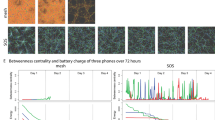Abstract
Wireless Sensor Network (WSN) is used in Emergency Management System (EMS). If emergency situation happens, real-timely transmitting emergency information in dynamically changing environment should be assured. But this requirement could not be satisfied by conventional approaches which are based on static situation and centralized management. In this paper, to satisfy this requirement, autonomous community construction technology is proposed for single emergency. Emergency information could be transmitted in community and protected from interference of other information’s transmission. Moreover, autonomous coordination technology is proposed for multiple emergencies’ information’s transmission. Via this technology, each emergency could have its individual route to transmit emergency information. Each emergency information’s transmission will not influence with each other. Evaluation results are provided to demonstrate the improvement.
















Similar content being viewed by others
References
Akyildiz, I. F., Su, W., Sankarasubramaniam, Y., & Cayirci, E. (2002). Wireless sensor networks: a survey. Computer Networks, 38, 393–422.
Estrin, D., Govindan, R., Heidemann, J., & Kumar, S. (1999). Next century challenges: scalable coordination in sensor networks. In Proceedings of the 5th annual ACM/IEEE international conference on mobile computing and networking, USA (pp. 263–270).
Lorincz, K., Malan, D. J., Fulford-Jones, T. R. F., Nawoj, A., Clavel, A., Shnayder, V., Mainland, G., Welsh, M., & Moulton, S. (2004). Sensor networks for emergency response: challenges and opportunities. IEEE Pervasive Computing, 3(4), 16–23.
Li, S., Lin, Y., Son, S. H., Stankovic, J. A., & Wei, Y. (2004). Event detection services using data service middleware in distributed sensor networks. Telecommunications Systems, 26(2), 351–368.
Low, K. S., Win, W. N. N., & Er, M. J. (2005). Wireless sensor networks for industrial environments. In Proceedings of the 2005 international conference on computational intelligence for modelling, control and automation, and international conference on intelligent agents, web technologies and Internet commerce (CIMCA-IAWTIC ’05), Vienna, November 2005 (pp. 271–276).
Abbas, C. B., González, R., Cardenas, N., & García, V. (2008). A proposal of a wireless sensor network routing protocol. Telecommunications Systems, 38(1), 61–68.
Liu, H.-J., Huang, M.-W., Hsieh, W.-S., & Jan, C. J. (2009). Priority-based hybrid protocol in wireless sensor networks. In Proceedings of 11th IEEE international conference on high performance computing and communications (HPCC ’09) (pp. 214–221).
Boukerche, A., Araujo, R. B., & Villas, L. (2006). A wireless actor and sensor networks QoS-aware routing protocol for the emergency preparedness class of applications. In Proceedings of 31st IEEE conference on local computer networks (pp. 832–839).
Mori, K. (1993). Autonomous decentralized systems: concept, data field architecture and future trends. In Proceedings of the international symposium on autonomous decentralized systems (ISADS ’93), Kawasaki, Japan (pp. 28–34).
Mahmood, K., Lu, X., Horikoshi, Y., & Mori, K. (2009). Autonomous pull-push community construction technology for high-assurance. IEICE Transactions on Information and Systems, E92-D(10), 1836–1846).
Tia, G., Pesto, C., Selavo, L., Yin, C., Jeong, G. K., Lim, J. H., Terzis, A., Watt, A., Jeng, J., Bor-rong, C., Lorincz, K., & Welsh, M. (2008). Wireless medical sensor networks in emergency response: implementation and pilot results. In Proceedings of IEEE conference on technologies for homeland security (pp. 187–192).
Petersen, S., Carlsen, S., & Talevski, A. (2008). Industrial IT revolution through wireless sensor network technologies. In Proceedings of IEEE first conference on industry IT revolutions (pp. 1–6).
Pogkas, N., Karastergios, G., Antonopoulos, C., Koubias, S., & Papadopoulos, G. (2005). An ad-hoc sensor network for disaster relief operations. In Proceedings of 10th IEEE conference on emerging technologies and factory automation (Vol. 2, pp. 131–139).
Niki, S., Murakami, S., Mahmood, K., Lu, X., & Mori, K. (2009). Autonomous decentralized community wireless sensor network architecture to achieve high-speed connectivity under dynamical situation. In Proceedings of 9th IEEE international symposium on autonomous decentralized systems (ISADS ’09) (pp. 297–304).
Ahlberg, M., Vlassov, V., & Yasui, T. (2006). Router placement in wireless sensor networks. In Proceedings of IEEE international conference on mobile adhoc and sensor systems (MASS ’06) (pp. 538–541).
Institute of Electrical and Electronics Engineers, Inc. (2003). IEEE std. 802.15.4-2003. wireless medium access control (MAC) and physical layer (PHY) specifications for low rate wireless personal area networks (LR-WPANs). New York: IEEE Press.
Barontib, P., Pillaia, P., Chooka, V. W. C., Chessab, S., Gottab, A., & Hu, Y. F. (2007). Wireless sensor networks: a survey on the state of the art and the 802.15.4 and ZigBee standards. Computer Communications, 30(7), 1655–1695.
Vakil, S., & Liang, B. (2006). Balancing cooperation and interference in wireless sensor networks. In Proceedings of 3rd annual IEEE communications society on sensor and ad hoc communications and networks (SECON ’06) (Vol. 1, pp. 198–206).
Akyildiz, I. F., Wang, X., & Wang, W. (2005). Wireless mesh networks: a survey. Computer Networks, 47(4), 445–487.
Zhou, G., He, T., Stankovic, J. A., & Abdelzaher, T. (2005). RID: radio interference detection in wireless sensor networks. In Proceedings of 24th annual joint conference of the IEEE computer and communications societies (INFOCOM 2005) (Vol. 2, pp. 891–901).
Intanagonwiwat, C., Govindan, R., Heidemann, J., Silva, F., & Estrin, D. (2003). Directed diffusion for wireless sensor networking. IEEE/ACM Transactions on Networking, 11(1), 2–16.
Shakshuki, E., Malik, H., & Denko, M. (2008). Software agent-based directed diffusion in wireless sensor network. Telecommunications Systems, 38(3), 161–174.
Perkins, C. E., & Royer, E. M. (1999). Ad-hoc on-demand distance vector routing. In Proceedings of second IEEE workshop on mobile computing systems and applications (WMCSA ’99), New Orleans, November 1999 (pp. 90–100).
Perkins, C. E., & Royer, E. M. (1994). Highly dynamic destination-sequenced distance-vector routing for mobile computers. In Proceedings of the conference on communications architectures, protocols and applications (SIGCOMM ’94), London, UK, September 1994 (pp. 234–244).
Author information
Authors and Affiliations
Corresponding author
Rights and permissions
About this article
Cite this article
Wei, F., Haque, M.E., Lu, X. et al. Autonomous community construction and coordination technology to achieve real-time transmission in multiple emergencies’ situation. Telecommun Syst 54, 61–78 (2013). https://doi.org/10.1007/s11235-013-9716-z
Published:
Issue Date:
DOI: https://doi.org/10.1007/s11235-013-9716-z




